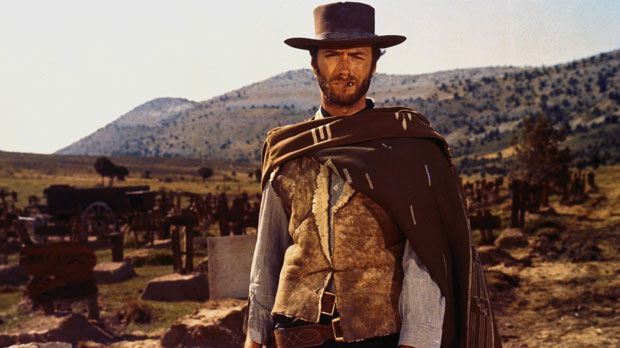
The Good, the Bad and the Ugly (1966) United Artists/Western RT: 178 minutes Rated R (violence, language, brief rear nudity) Director: Sergio Leone Screenplay: Agenore Incrocci (as “Age”), Furio Scarpelli (as “Scarpelli”), Luciano Vincenzoni and Sergio Leone Music: Ennio Morricone Cinematography: Tonino Delli Colli Release date: December 23, 1966 (Italy)/December 29, 1967 (US) Cast: Clint Eastwood, Lee Van Cleef, Eli Wallach, Aldo Guiffre, Luigi Pistilli, Rada Rassimov, John Bartha, Livio Lorenzon, Antonio Casale, Antonio Casas. Box Office: $25.1 million (US)
Rating: ****
The Good, the Bad and the Ugly, the third and final installment in Sergio Leone’s Man with No Name trilogy, is an epic in every sense of the word. It’s the Gone with the Wind of spaghetti westerns. It plays out against the backdrop of the American Civil War. The three main characters are taciturn bounty hunter Blondie (“The Good”), ruthless mercenary Angel Eyes (“The Bad”) and cagey Mexican bandit Tuco (“The Ugly”). They’re all after a hidden stash of stolen Confederate gold, $200,000 to be exact.
Blondie (Eastwood) and Tuco (Wallach, The Magnificent Seven) have a pretty good scam going. It works like this. Blondie “captures” Tuco and delivers him to the local sheriff to collect the bounty. He waits until the hangman’s noose is around his partner’s neck before freeing him and escaping into the desert where they split the money. Blondie grows tired of Tuco’s constant complaining and abruptly ends the partnership, leaving the disgruntled bandit stranded in the desert.
Angel Eyes (Van Cleef) is a sadistic SOB who never leaves any job unfinished. A man he’s sent to kill offers to pay him twice what he’s getting for this job to kill the man that hired him. He kills his target, takes the money and kills his original client. He’s searching for a Confederate officer going by the name of Bill Carson. He’s the one that stole and hid the gold.
The location of the gold is finally revealed when Blondie and Tuco encounter a dying Carson in the desert. At the time, a vengeful Tuco is marching Blondie to his death in the blazing hot desert. He’s very near death when they meet Carson who reveals the name of the cemetery to Tuco and the exact location to Blondie. If they intend to retrieve the gold, the two men have no choice but to work together.
With a running time just shy of three hours, you might think The Good, the Bad and the Ugly is too much of a good thing. It’s actually not. Leone tells a compelling story painted on a huge sprawling canvas of breathtaking landscapes and large-scale Civil War battles. Ennio Morricone contributes yet another beautiful score including the iconic theme song, a two-pitch melody that sounds like a howling coyote. He uses different variations for each of the three main characters- a flute for Blondie, an ocarina for Angel Eyes and human voices for Tuco. I LOVE what Morricone does! He consistently creates unique and distinctive scores, often incorporating unusual instruments and sounds. Sometimes the music underscores the violence and brutality prevalent in Civil War-era America. There’s one scene where a chorus of Confederate soldiers in a prison camp sing “The Story of a Soldier” while Angel Eyes, disguised as a Union officer, has Tuco beaten and tortured until he reveals what he knows about the buried treasure. It’s an amazing scene, one of several in a movie with no bad scenes.
It goes without saying that Eastwood is great in The Good, the Bad and the Ugly. I read somewhere that this third movie is meant to be a prequel to the first two. If that’s true, it explains why he doesn’t don his trademark poncho until the finale, a three-way Mexican standoff in a cemetery. It’s prolonged to the point where you almost can’t stand the suspense. As usual, it bears Leone’s signature close-up shots of the characters’ faces and eyes. Van Cleef, a total bastard here, makes an excellent villain with his squinty-eyed stare and trademark pipe clenched between his teeth. Wallach is an excellent addition to the cast. Tuco is a cunning yet oafish fast-talker that comes off as comical rather than despicable. Interestingly enough, he’s the only character with a backstory revealed in a tense conversation with his brother (Pistilli, For a Few Dollars More). Well, it’s tense for the brother, a priest at the mission where Tuco takes Blondie to recover from his ordeal in the desert. ANYWAY, you understand Tuco a little better after hearing his tale of woe.
I LOVE all three of the Man with No Name films, but The Good, the Bad and the Ugly is a true masterpiece. It’s HUGE! It has all of Leone’s signature moves and more. It’s violent, beautiful, thrilling and epic in scope. There’s no better augmentation than Morricone’s brilliant score. I like everything he does. I feel the same about Leone and (mostly) Eastwood. I just don’t feel the love for The Bridges of Madison County. Thankfully, I can always rely on any of his westerns for enjoyment, Leone’s spaghetti westerns in particular. All three are WINNERS! I always like to watch them in order of release even though you could conceivably watch one without seeing the others. It’s not like Star Wars where if you don’t watch them in order, you’re going to be lost. Me, I’m a purist. It just makes sense to watch the Man with No Name films in the order in which they were released. It’s a great way to spend the day, that’s for damn sure.





